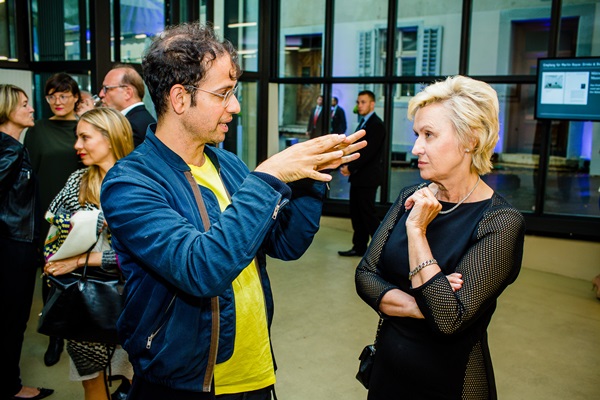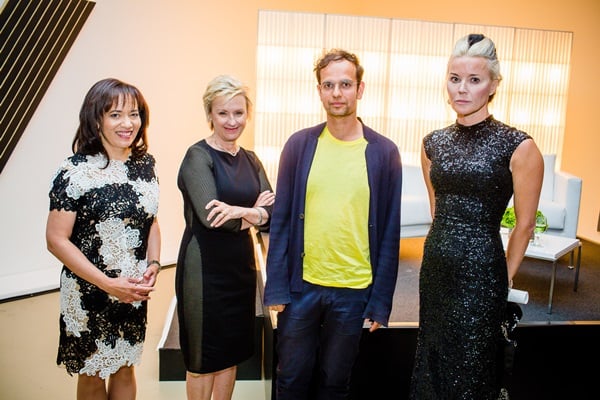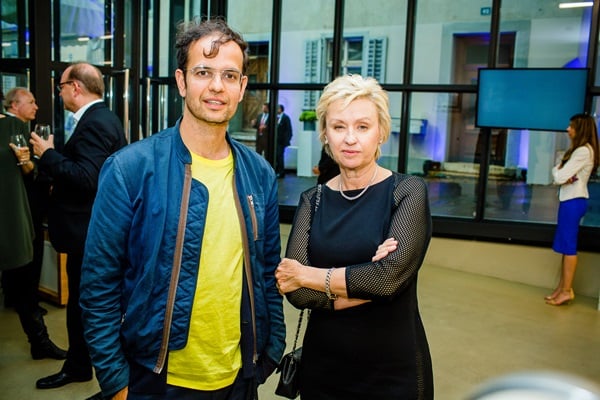Art Fairs
Pretentious Tino Sehgal Delivers Absurd Talk With Tina Brown to Baffled Bankers In Basel During Art Basel
Sometimes artists say really stupid things.

Photo: David Biedert Photography.
Sometimes artists say really stupid things.

Artnet News

Tuesday night, on the heels of a busy first day of previews at Art Basel, media maven Tina Brown took to the stage with the artist Tino Sehgal for a conversation at the Museum fur Gegenwartskunst followed by a dinner in the courtyard of the Gasthof zum Goldenen Sternen, next to the museum.
The event was hosted by Brown, Daphne Guinness, collector Richard Chang, and Credit Suisse’s Pamela Thomas-Graham. The crowd was filled with artists, dealers, collectors, and philanthropists, among them Gavin Brown, Liza Lou, Sadie Coles, and Danh Vo.
Flanked by works of Frank Stella (on a stage that with a backdrop of lighted squares and a potted plant resembled that of Zach Galifianakis’s comedy series “Between Two Ferns”), Brown and Sehgal chatted about materialism, the humor—or lack thereof—in Sehgal’s work, and why Rrikrit Tiravanija’s kitchen installation, outside the main entrance of Art Basel, couldn’t have happened just a few years ago.
It was interesting, at times, but the artist came off as utterly pretentious and filled with the most astonishing sense of self-importance. The crowd cringed as he extolled his own virtues; he seems to think of himself as a philosopher, and referred to Balanchine as “my crush of the moment.” Brown peddled briskly to keep the conversation going, a testament to her conversational skills.

Pamela Thomas Graham, Tina Brown, Tino Sehgal and Daphne Guiness.
Photo: David Biedert Photography.
But let’s not dwell on the worst of it. Here are a few choice, if inexplicable, quotes from the talk:
“One of the biggest civilizational achievements of the West, apart from soap, is the convention of opening hours. There are two modalities on which you can organize people: appointments…and opening hours.” Okay.
“We cannot be contemporary in a theater, it’s impossible.”
“Is your work a rebellion against materialism?” Brown asked. “Rebellion reminds me of being a teenager and reminds me of the 20th century. So, both those things don’t really interest me that much,” Sehgal replied. “I’m much more interested in you than in this chair. If someone asked me to spend ten minutes with this chair and ten minutes with you, I’d definitely choose you.”
“Material is thought of the most important site of substance. That’s a very Western, recent thing. No other country thinks that—it would always be spiritual activities.”

Tino Sehgal and Tina Brown.
Photo: David Biedert Photography.
“Most things in our society get passed on from body to body. That’s a very anxious Western idea, that things [remain] the same. This idea that objects are stable isn’t correct. We produce art, we don’t conserve art.”
In response to a question about how he ensures that a work is “as good as you want it to be,” Sehgal said, “I’m not sure I’m successful at that. There’s an appropriateness to a moment that can only happen in the live moment. That’s what you can do with human beings.”
In response to the question, “Is the humor of your work sometimes underestimated?” Sehgal responded: “I don’t busy myself with these questions. I was astonished when people found my work humorous because I didn’t really think of myself as a person with humor.”
“You’re an economist, and an artist and a visionary,” Brown said in a generous moment. “One of the biggest topics today that people talk about is the economic divide between the rich and the poor and it is a chronic global theme. What is the role of an artist in that conversation?”
His reply: “I’m much more concerned with the presumptions of this poor or rich thing. Because it’s based on this material wealth. The gross national product is just one indication of wealth. You could also say the amount of friends, or how much they’re rooted in a certain place, those are all indicators of wealth. The rich and poor divide is for me very material.”
“Here we are at Art Basel, a temple of objects. Any thoughts on Art Basel?” asked Brown, predictably.
“I was doing an interview earlier with this financial newspaper and they asked me the same questions. What values does Art Basel convey? One concrete way of answering that question is, if you look at the project of Rirkrit Tiravanija, there’s many interesting things about it.”
“They’ve built this kind of restaurant and they’re making food, people can participate in the making of food and what’s interesting about it, it’s very 2015, also the way Art Basel has presented it. There used to be all these sculptures around. Now they’re like, we’re just going to show one thing, one thing which is more healthy and looks good but is also social and inclusive. So it has a whole set of social values going on there.”
“If it’s art or not, I don’t know if that even matters. But it’s a kind of approach to contemporary life, which has surged in the last years. I don’t know if this thing would have been possible seven years ago.”
And one final gem, where Sehgal attempts to keep it real:
“I’m still a dancer, but I’m not an economist.”